NEW GLOUCESTER — Spring is in the air. But mud is on the ground, and will be for a while.
Mud season is an annual mucky rite of passage in the lives of northern New Englanders. This year, it’s gloppier than usual in places, and hanging around longer.
Even Acadia National Park in Maine had to close its famed carriage roads this season because of the mud, disappointing park visitors. The roads reopened last week but remained closed to horses because of the soft surface.
Mud season sets in when snow melts, ground softens and spring rains come. Parts of Maine, New Hampshire and Vermont had a snowier winter than usual, followed by a wetter-than-average spring, making for a longer lasting muddier mess.
Mud season is normally over by April, but forecasters say it could stick around until early May.
“Generally we would be done by now, but we’re still having rain and snow events,” said Victor Nouhan, a meteorologist with the National Weather Service in Caribou, Maine.
Caribou got nearly 125 inches of snow this winter, 15 inches more than the average. In the southern part of the state, Portland got 95.3 inches, well above the average 61.6 inches. Rainfall has also been heavy. Portland has had more than 15 inches of rain since Jan. 1 and averages less than 14 inches in that time.
The muddy late April means all-terrain vehicle enthusiasts who maintain 7,000 miles of trails in Maine are hard at work keeping people off the paths, said Real Deschaine, president of ATV Maine. ATV use during mud season can damage trails.
“There’s always somebody trying to find some muddy holes,” Deschaine said.
Parts of New Hampshire and Vermont also are still beset with mud after heavy winter snows. Concord, New Hampshire, averages 61.2 inches of snow but got 86.3 inches. In Burlington, Vermont, where more than 100 inches of snow fell, the average was exceeded by nearly 20 inches.
In Farmington, New Hampshire, it took Pat Frisella an extra 20 minutes to get to work Tuesday after a truck got stuck in the mud near her home and other vehicles coming to its aid blocked the road.
“I had to go the long way around because there was a second one of those huge tow trucks, a firetruck and a police car in the road,” she said. “That poor guy is as stuck as stuck can be.”
Paul Cerminara, the road foreman for the rural community of Middlesex, just outside the Vermont capital of Montpelier, said this year’s just-ending mud season was about normal, but coming after two or three years of easy seasons it seemed worse.
Crews Tuesday were pouring gravel into one low-lying muddy spot in some woods, which keeps the sun from drying it out. Over the last several years, Cerminara has worked with town officials to fix the traditionally troublesome spots by making sure the road can drain. They’re making progress.
“Mud season, it was just a fact of spring. When the sap started running, the roads went to hell,” Cerminara said. “Now, I’ll tread lightly, but folks don’t want to hear the road’s not passable right now. And I get that. It’s just not acceptable in this day and age.”
Associated Press writers David Sharp in Portland, Maine; Wilson Ring in Middlesex, Vermont; and Holly Ramer in Farmington, New Hampshire, contributed to this story.
Send questions/comments to the editors.




Success. Please wait for the page to reload. If the page does not reload within 5 seconds, please refresh the page.
Enter your email and password to access comments.
Hi, to comment on stories you must . This profile is in addition to your subscription and website login.
Already have a commenting profile? .
Invalid username/password.
Please check your email to confirm and complete your registration.
Only subscribers are eligible to post comments. Please subscribe or login first for digital access. Here’s why.
Use the form below to reset your password. When you've submitted your account email, we will send an email with a reset code.